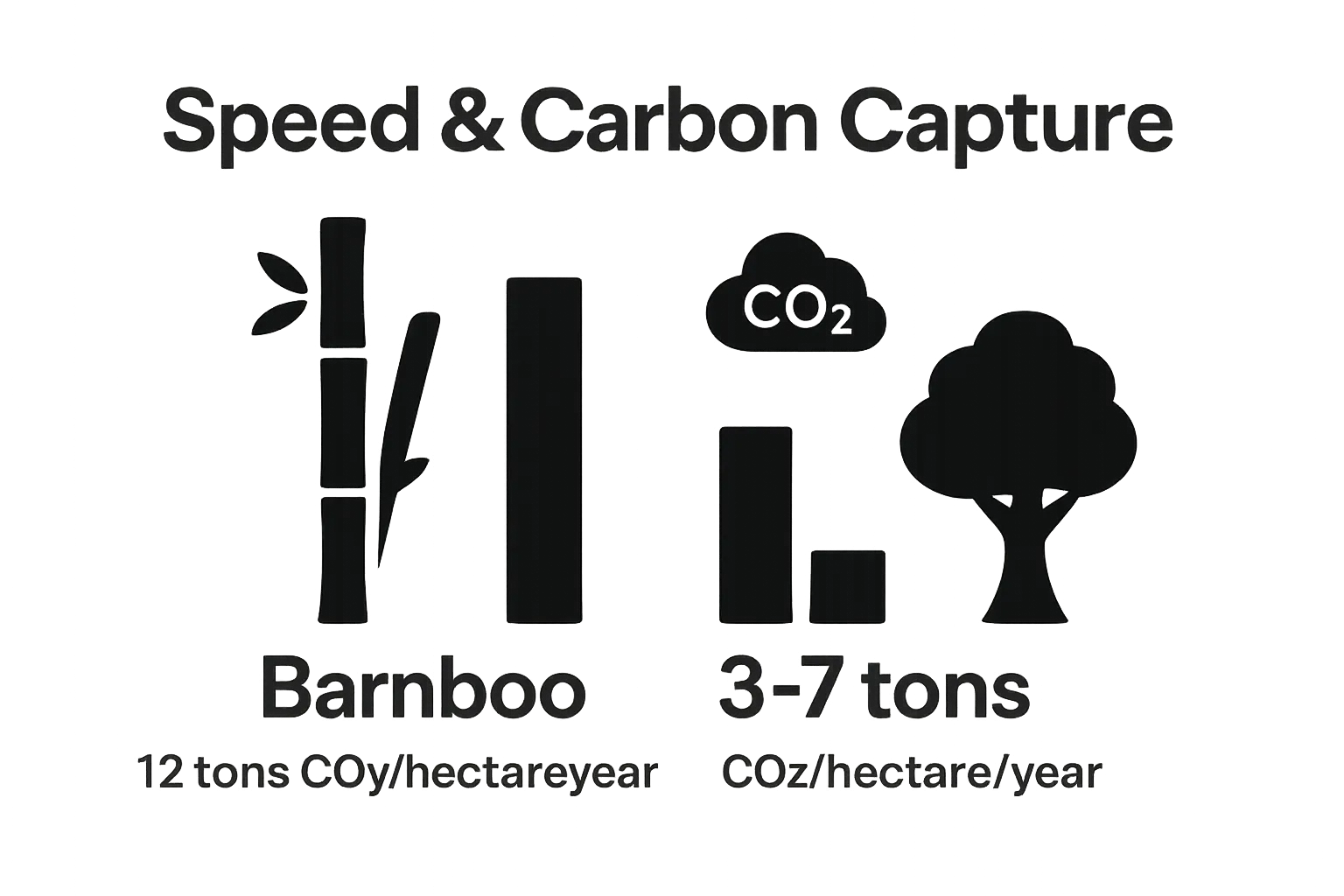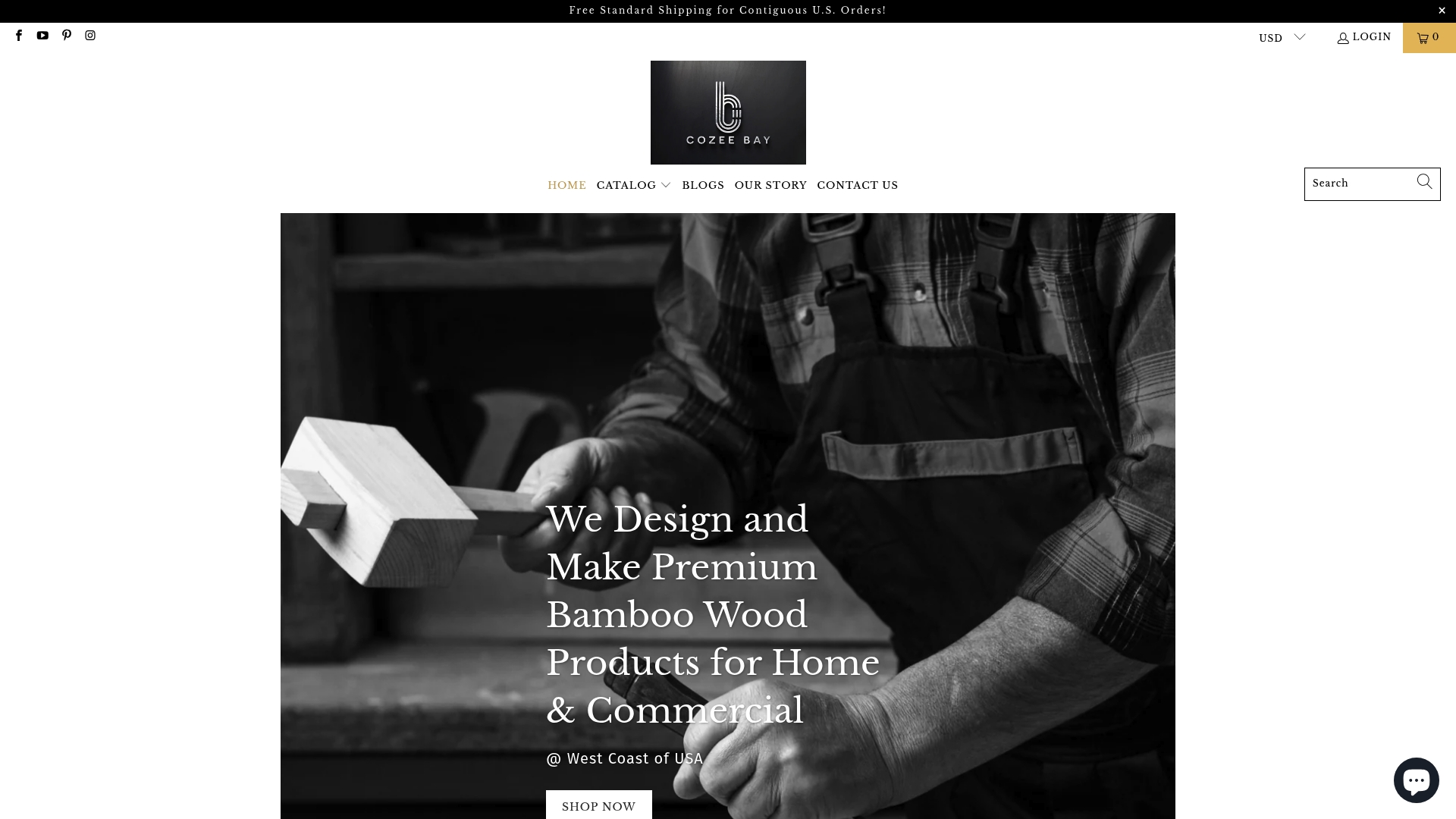Your Cart is Empty
Free Standard Shipping for Contiguous U.S. Orders!
Free Standard Shipping for Contiguous U.S. Orders!
Catalog

Understanding Why Bamboo is Sustainable for Your Home
October 06, 2025 9 min read
Bamboo seems like just another green plant in the wild, but its abilities make it stand out from the rest. Some bamboo species can grow up to 36 inches in a single day, which is faster than almost anything else on the planet. Most people think of bamboo as a simple material for furniture or flooring, but that kind of speed and strength means bamboo might be nature’s most overlooked powerhouse.
Table of Contents
- What Is Bamboo And Its Unique Properties?
- The Environmental Benefits Of Bamboo Growth
- How Bamboo Contributes To Sustainable Building Materials
- Bamboo’s Role In Eco-Friendly Home Decor And Design
- Challenges And Considerations In Using Bamboo Sustainably
Quick Summary
| Takeaway | Explanation |
|---|---|
| Bamboo grows extraordinarily fast | Certain bamboo species can grow up to 36 inches per day, making it unique among plants. |
| Bamboo improves soil health | Its extensive root system prevents erosion and enhances soil quality in degraded areas. |
| Bamboo is a strong building material | With tensile strength comparable to steel, bamboo is ideal for sustainable construction. |
| Bamboo sequesters significant carbon | Bamboo plantations can absorb up to 12 tons of CO2 per hectare annually, aiding climate mitigation. |
| Bamboo requires minimal resources | It thrives with little water and without the need for pesticides, ensuring its sustainability. |
What is Bamboo and Its Unique Properties?
Bamboo represents a remarkable natural resource that transcends traditional perceptions of wood and plant materials. Unlike typical timber, bamboo is actually a type of grass that grows with extraordinary speed and resilience, making it a sustainable powerhouse in ecological design and manufacturing.
The Botanical Characteristics of Bamboo
At its core, bamboo is a member of the Poaceae grass family, characterized by its hollow stems called culms and incredible growth potential. Research from the International Bamboo and Rattan Organization reveals that some bamboo species can grow up to 91 centimeters (36 inches) in a single day, representing one of the fastest-growing plants on Earth. This rapid growth cycle sets bamboo apart from traditional forestry resources, enabling quick regeneration without requiring replanting.
Key botanical characteristics include:
- Hollow stem structure providing lightweight yet strong material
- Extensive root network that prevents soil erosion
- Natural ability to self-regenerate after harvesting
- No need for pesticides or extensive agricultural interventions
Sustainability and Environmental Impact
Bamboo’s sustainability credentials extend far beyond its rapid growth. The plant absorbs significant amounts of carbon dioxide and generates up to 35% more oxygen compared to equivalent tree stands. Its root system remains intact after harvesting, which means continuous soil stabilization and prevention of erosion. Environmental Science research demonstrates that bamboo forests can sequester approximately 12 tons of carbon dioxide per hectare annually.
Moreover, bamboo requires minimal water and can thrive in diverse ecological conditions, from tropical regions to temperate zones. This adaptability makes it an exceptional sustainable material for understanding why bamboo for home products matters. Its natural properties make it resistant to bacteria, moisture, and warping, presenting an ideal material for home applications ranging from kitchenware to structural elements.
The Environmental Benefits of Bamboo Growth
Bamboo emerges as a remarkable ecological solution that goes far beyond traditional plant resources, offering profound environmental advantages that distinguish it from other agricultural and forestry materials. Its unique growth characteristics and regenerative properties position bamboo as a critical tool in combating climate change and promoting sustainable development.
Carbon Sequestration and Climate Mitigation
Bamboo’s exceptional capacity for carbon absorption makes it a powerful natural carbon sink. Research from the International Network for Bamboo and Rattan indicates that bamboo plantations can sequester up to 12 tons of carbon dioxide per hectare annually, significantly outperforming many traditional forest ecosystems. This extraordinary carbon capture potential stems from bamboo’s rapid growth rate and dense biomass production.

Key carbon sequestration benefits include:
- Faster carbon absorption compared to traditional tree species
- Continuous carbon capture during rapid growth cycles
- Minimal land use requirements for substantial carbon mitigation
- Ability to thrive in degraded and marginal agricultural lands
Ecosystem Restoration and Soil Health
Beyond carbon sequestration, bamboo plays a crucial role in ecosystem restoration and soil preservation. Its extensive root network stabilizes soil, prevents erosion, and can rehabilitate degraded landscapes. Unlike conventional crops that deplete soil nutrients, bamboo actually improves soil quality through its complex root system and natural organic matter recycling. Environmental Science research demonstrates that bamboo can restore soil structure and fertility in areas previously considered unsuitable for agriculture.
Moreover, bamboo requires minimal pesticides and fertilizers, making it an environmentally friendly crop that supports biodiversity and understanding the environmental benefits of bamboo. Its ability to grow in diverse ecological conditions without significant human intervention underscores its potential as a sustainable agricultural resource with minimal environmental impact.
This table outlines the key environmental benefits of bamboo growth, organizing the main ecological advantages described in the article for quick reference.
| Environmental Benefit | Description |
|---|---|
| Rapid Carbon Sequestration | Bamboo absorbs up to 12 tons of CO2 per hectare annually |
| Continuous Soil Stabilization | Extensive root network prevents soil erosion and restores degraded land |
| Low Water Usage | Thrives with minimal water compared to traditional crops |
| Biodiversity Support | Grows in diverse regions, supports healthy ecosystems |
| Minimal Chemical Inputs | Rarely needs pesticides or fertilizers for healthy growth |
| Organic Matter Recycling | Improves soil quality through natural recycling |
| Adaptability | Grows in both tropical and temperate environments |

How Bamboo Contributes to Sustainable Building Materials
Bamboo represents a revolutionary material transforming sustainable construction practices, offering an eco-friendly alternative to traditional building materials that reduces environmental impact while maintaining exceptional structural integrity and performance characteristics.
Structural Properties and Performance
Unlike conventional timber, bamboo possesses remarkable mechanical properties that make it an outstanding building material. Research from the International Network for Bamboo and Rattan reveals that bamboo’s tensile strength rivals steel, with some species demonstrating comparable strength-to-weight ratios. This extraordinary characteristic allows architects and builders to create lightweight yet incredibly robust structures that can withstand significant environmental stresses.
Key structural advantages of bamboo include:
- Exceptional strength-to-weight ratio
- High flexibility and earthquake resistance
- Natural durability against moisture and decay
- Renewable and rapidly regenerative material
Sustainable Construction Applications
Bamboo’s versatility extends across multiple construction domains, from residential housing to complex architectural designs. Green building professionals increasingly recognize bamboo as a sustainable alternative that significantly reduces carbon footprint. Sustainable Design Research indicates that bamboo construction can reduce embodied carbon by up to 70% compared to conventional concrete and steel structures.
Moreover, bamboo’s modular growth pattern enables prefabrication techniques that streamline construction processes, reducing waste and labor costs. Its natural properties provide excellent thermal and acoustic insulation, contributing to energy-efficient building design. Understand the reasons to choose bamboo for sustainability reveals how this remarkable material is revolutionizing sustainable architecture worldwide, offering a genuine alternative to resource-intensive traditional building materials.
Bamboo’s Role in Eco-Friendly Home Decor and Design
Bamboo transcends its traditional utilitarian reputation, emerging as a sophisticated design material that seamlessly blends aesthetic appeal with environmental consciousness. Its natural texture, versatility, and sustainable credentials make it an increasingly popular choice among interior designers and homeowners seeking to create beautiful, environmentally responsible living spaces.
Aesthetic and Functional Design Properties
The unique visual characteristics of bamboo set it apart from conventional home decor materials. Interior Design Research demonstrates that bamboo offers a warm, organic texture that introduces natural elegance into contemporary and traditional design schemes. Its inherent grain patterns and subtle color variations provide designers with a rich palette of design possibilities, from minimalist Scandinavian styles to rustic and bohemian interiors.
Key design advantages of bamboo include:
- Versatile color ranges from light honey to deep caramel tones
- Natural grain patterns that add visual depth and character
- Lightweight yet durable material suitable for multiple design applications
- Hypoallergenic surface that resists bacterial growth
Sustainable Home Decor Applications
Beyond its aesthetic qualities, bamboo represents a revolutionary approach to home decor that prioritizes environmental responsibility. Sustainable Design Journal indicates that bamboo products require significantly less energy to manufacture compared to traditional materials like plastic or metal. From kitchen utensils and furniture to decorative panels and lighting fixtures, bamboo offers an eco-friendly alternative that does not compromise on style or functionality.
Moreover, bamboo’s natural antimicrobial properties make it an excellent material for high-touch home items. Why choose bamboo decor: understanding its benefits reveals how this remarkable material is transforming home design, providing homeowners with sustainable, beautiful, and practical solutions that reflect a commitment to environmental stewardship.
Challenges and Considerations in Using Bamboo Sustainably
While bamboo represents a promising sustainable material, its widespread adoption is not without complex environmental and economic challenges. Understanding these nuanced considerations is crucial for consumers and industries seeking to implement truly responsible bamboo solutions.
Manufacturing and Processing Complexities
The transformation of raw bamboo into usable products involves intricate processes that can potentially undermine its environmental benefits. Research from the International Bamboo and Rattan Organization reveals that traditional manufacturing techniques often require significant chemical treatments and energy consumption, which can offset the material’s inherent sustainability. Responsible manufacturers must carefully balance production efficiency with ecological preservation.
Key manufacturing challenges include:
- High energy requirements for converting bamboo into finished products
- Potential use of toxic chemicals during treatment processes
- Complex supply chain logistics for global distribution
- Variability in manufacturing standards across different regions
Environmental and Economic Sustainability Concerns
Despite bamboo’s rapid growth, large-scale cultivation can create unexpected ecological pressures. Sustainable Agriculture Research highlights potential monoculture risks, where extensive bamboo plantations might reduce biodiversity and disrupt local ecosystems. Moreover, the economic incentives for bamboo cultivation can lead to unregulated expansion that may harm existing agricultural landscapes.
Moreover, consumers must critically evaluate bamboo products to ensure genuine sustainability. Why choose bamboo home products: sustainable living explained emphasizes the importance of understanding manufacturing origins, certifications, and the complete environmental footprint of bamboo goods. Responsible consumption requires looking beyond surface-level sustainability claims and examining the comprehensive ecological impact of bamboo production.
Bring Sustainable Bamboo Living Home With Cozee Bay
Have you been searching for ways to make your home or workplace more eco-friendly without compromising on quality or style? The article you just read spotlights how bamboo’s rapid growth, soil-saving roots, and low environmental impact set it apart from traditional materials. These features matter if you want attractive, durable home products that truly support the planet. Many people want products that look great and provide everyday functionality but worry about the hidden environmental cost. At Cozee Bay, we understand your concerns and are committed to genuine sustainability, not just claims.

It is easy to take action today. Explore our curated collection of bamboo essentials and find options like handcrafted paper towel dispensers, drawer organizers, and more that match what you care about. Each item is made with responsible materials and craftsmanship, designed to help you live more sustainably every day. Ready to see the difference? Discover our full eco-friendly bamboo selection and read more on why bamboo products make sense for your home. Make your next home purchase good for you and good for the environment at Cozee Bay before our latest stock runs out.
Frequently Asked Questions
What are the environmental benefits of using bamboo for home products?
Bamboo is sustainable as it absorbs significant amounts of carbon dioxide, generates more oxygen than many tree species, and prevents soil erosion with its extensive root network. Its ability to grow rapidly and require minimal water makes it an eco-friendly option for various home products.
How does bamboo compare to traditional timber in terms of sustainability?
Unlike traditional timber, bamboo is a grass that grows much faster and regenerates quickly without needing replanting. It also has a lower carbon footprint during its production process, thus presenting a more sustainable option for construction and home decor.
The following table compares bamboo to traditional timber based on several sustainability and performance factors discussed in the article. This can help readers understand why bamboo is considered a superior eco-friendly material.
| Factor | Bamboo | Traditional Timber |
|---|---|---|
| Growth Rate | Up to 36 inches per day | Several years to decades |
| Regeneration | Self-regenerates without replanting | Requires replanting after harvest |
| Carbon Sequestration | Absorbs up to 12 tons CO2/ha/yr | Lower annual CO2 absorption |
| Oxygen Production | Up to 35% more oxygen than trees | Lower oxygen output |
| Resource Needs | Minimal water, no pesticides | More water, possible chemical use |
| Soil Impact | Prevents erosion, improves soil health | Can cause soil degradation |
| Durability | High tensile strength, resists moisture and decay | Varies by species, may require treatment |
Is bamboo durable enough for everyday home use?
Yes, bamboo is highly durable due to its unique structural properties. It has a high strength-to-weight ratio, is resistant to moisture and decay, and can withstand significant wear and tear, making it suitable for kitchenware, furniture, and other everyday applications.
What should I consider when choosing bamboo products for my home?
When selecting bamboo products, consider the manufacturing process and ensure they are sourced from responsible producers. Look for certifications that verify sustainable practices and be aware of potential chemical treatments used during production to minimize environmental impact.
Recommended
- Cozee Bay - Understanding Why Bamboo for Home Products Matters
- Cozee Bay - Why Choose Bamboo Home Products: Sustainable Living Explained
- Cozee Bay - 7 Top Uses for Bamboo in Homes You Need to Know
- Cozee Bay - Understanding the Benefits of Bamboo for Homes
- Understanding Sustainable Construction Materials: A Comprehensive Guid – Mats4U
Leave a comment
Comments will be approved before showing up.
Subscribe
Sign up to get the latest on sales, new releases and more …

